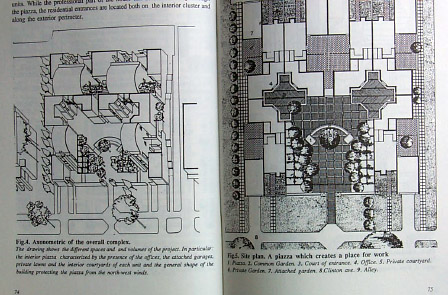FitzGibbon Visiting Professor Chair
Department of Architecture
Carnegie-Mellon
ext: 81963 mm204a
http://128.2.125.249
9/7/2001
General talk to the fourth year students.
Part I. Occupancy as the Structure of design decisions
80-90ss
1. I came in Carnegie-Mellon in 1983 to study Housing. The topic of Occupancy was absolutely central in that framework.
Actually occupancy was THE way through which one was supposed to approach architecture (except one were a "formalist") and back at that time to be a formalist meant to work in a post modern fashion with arches and columns). I was educated instead in the typical modernist attitude. i.e.: "they are the needs -- particularly the social needs -- which structure "choices" in architecture.
Occupancy therefore was the driving force of our decision making process
What we meant by the word Occupancy was a "social, psychological, personal, even individualized" interpretation of the use of space at all scales.
I studied Housing within this conceptual framework, particularly what was called "low rise-high density housing". My master and mentor was Louis Sauer at that time Department head and very well known architect in Usa particularly for his many projects in the society Hill Area in Philadelphia


(on Louis Sauer you can read this text in English or see the Images here)
Beside that book I design several project exactly with the explicit of attitude of occupancy that I described.
In particular a project for "A new American House" became
also a book.
It dealt with the issue of working at home and changing
family styles.
In that case a key instrument to localized the issue of occupancy was the task to write a serious of Scenarios to which the design decision has to conform.


After That many other studies were done, Particularly in the area of "New Households New Housing" coming from research done in the 80s and 90s in order to understand how changes the relationship between housing and community living when one poses the problem of sharing at the center of the process
Antonino Saggio, Co-Residenza. Nuove famiglie e progettazione
della casa Nel numero monografico di Edilizia Popolare",
n. 228-229, luglio-ottobre 1993 (pp. 4-21) dedicato al tema dei Nuovi modi
di Vita
NEW HOUSEHOLDS NEW HOUSING, di K. FRANCK E S. AHRENTZEN
see review Domus, n. 726, aprile 1991 (p.VI).
See The Un-private House Exhibition

Part II. Occupancy as the Driving Force of design
decisions
00s
We are in the oos (year 2001, September 9 for the precision)
and we have to start over.
Because the world is changed or saying it better, because
our consciousness of the fact of the word is changed.
As you know, society to day is organized around the production of information and not only of manufactured goods.
This changed every thing.
Particularly our notion of specific building types.
There is more and more a search for mixite (for combing
uses and functions in what my class call an anti-zoning attitude)
Therefore. How do we start over?
We have to work at a much higher level of complexity from that I described in the first part.
So we must re-invent our notion of occupancy, re-invent our way to structure the difference forces that shape architecture today.
Working within this framework is the specific challenge
of my approach to teaching this term
Occupancy
habitation
occupation
inhabitance
settlement
residence
inhabitation
possessionSketch From AS Class lecture thata shows the five basic areas of functionl thinking, their interconnection and the concept of driving force
Sketch by E. Parker